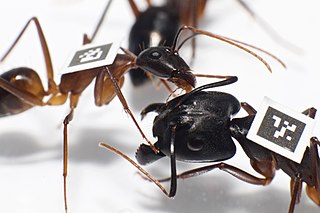
Ants are eusocial insects of the family Formicidae and, along with the related wasps and bees, belong to the order Hymenoptera. Ants evolved from vespoid wasp ancestors in the Cretaceous period. More than 13,800 of an estimated total of 22,000 species have been classified. They are easily identified by their geniculate (elbowed) antennae and the distinctive node-like structure that forms their slender waists.

Carpenter ants are large ants indigenous to many forested parts of the world.

The banded sugar ant, also known as the sugar ant, is a species of ant native to Australia. A member of the genus Camponotus in the subfamily Formicinae, it was described by German entomologist Wilhelm Ferdinand Erichson in 1842. Its common name refers to the ant's liking for sugar and sweet food, as well as the distinctive orange-brown band that wraps around its gaster.

Nothomyrmecia, also known as the dinosaur ant or dawn ant, is an extremely rare genus of ants consisting of a single species, Nothomyrmecia macrops. These ants live in South Australia, nesting in old-growth mallee woodland and Eucalyptus woodland. The full distribution of Nothomyrmecia has never been assessed, and it is unknown how widespread the species truly is; its potential range may be wider if it does favour old-growth mallee woodland. Possible threats to its survival include habitat destruction and climate change. Nothomyrmecia is most active when it is cold because workers encounter fewer competitors and predators such as Camponotus and Iridomyrmex, and it also increases hunting success. Thus, the increase of temperature may prevent them from foraging and very few areas would be suitable for the ant to live in. As a result, the IUCN lists the ant as Critically Endangered.

Camponotus nearcticus, commonly named smaller carpenter ant, is a relatively small carpenter ant. Its appearance is similar to Lasius niger, commonly named the black garden ant. The ant is a household pest.

Acromyrmex striatus is a species of the leaf-cutter ants found in the Neotropics.
Colobopsis anderseni, synonym Camponotus anderseni, is a species of mangrove ant found in northern Australia.

Cyphomyrmex is a genus of fungus-growing ants found primarily in South and Central America. However, some species do come up to the southern portion of North America. They grow a variety of fungi in the tribe Leucocoprineae. Most fungal gardens are grown in small nodules, some species to cultivate entire mycelium, though. Colonies are monogynous and are relatively small with about 100 workers on average.

Dinoponera is a strictly South American genus of ant in the subfamily Ponerinae, commonly called tocandiras or giant Amazonian ants. These ants are generally less well known than Paraponera clavata, the bullet ant, yet Dinoponera females may surpass 3–4 cm (1.2–1.6 in) in total body length, making them among the largest ants in the world.

Myrmelachista is a Neotropical genus of ants in the subfamily Formicinae. The genus is found exclusively in the Neotropical realm. Little is known regarding their biology.

Forelius pruinosus, commonly known as the high noon ant, is a species of ant in the genus Forelius. Described by Roger in 1863, the species is endemic to North America and has been recently observed in Latin America.

The black-headed sugar ant, also known as the brown sugar ant, is a species of Formicinae ant endemic to Australia. Found throughout most states, the species is a member of the genus Camponotus, a cosmopolitan genus of ants commonly known as carpenter ants. It was formally described and named by British entomologist Frederick Smith in 1858. These ants are characterised by their black head, reddish-brown mesosoma and black gaster, which can change in colour.

The Brazil men's national under-23 volleyball team represents Brazil in international men's volleyball competitions and friendly matches under the age 23 and it is ruled by the Brazilian Volleyball Federation that is a member of South American volleyball body Confederación Sudamericana de Voleibol (CSV) and the international volleyball body government the Fédération Internationale de Volleyball (FIVB).

The Brazil men's national under-21 volleyball team represents Brazil in international men's volleyball competitions and friendly matches under the age 21 and it is ruled by the Brazilian Volleyball Federation that is a member of South American volleyball body Confederación Sudamericana de Voleibol (CSV) and the international volleyball body government the Fédération Internationale de Volleyball (FIVB).

The Brazil men's national under-19 volleyball team represents Brazil in international men's volleyball competitions and friendly matches under the age 19 and it is ruled by the Brazilian Volleyball Federation that is a member of South American volleyball body Confederación Sudamericana de Voleibol (CSV) and the international volleyball body government the Fédération Internationale de Volleyball (FIVB).
Camponotus vittatus is a species of carpenter ant and one of the most common ants found around households in South America, particularly Brazil. It was originally described by Auguste Forel in 1904. The species is relatively large, caramel-coloured, omnivorous, and fast-moving. The species presents four larval stages which will spin a cocoon to pupate. The hairs of Camponotus larvae are quite abundant, and may present taxonomic importance. The larvae of both sexes are similar, with few diagnostic traits, such as the acquired shape towards pupation inside their cocoons.
Camponotus textor, also known as Brazilian weaver ant, is a species of fairly common tree-dwelling ant native to South and Central America. It is believed to include a number of cryptic species, and previously were considered synonymous to the cavity-dwelling ant Camponotus senex, now thought to be only distantly-related.

Camponotus fellah is a species of carpenter ant found across the Middle East and North Africa. This species was formally described by Dalla Torre in 1893. A C. fellah queen holds the record for Israeli ant longevity, surviving for 26 years (1983-2009) in a laboratory environment.
Dendromyrmex is a subgenus of carpenter ants.













